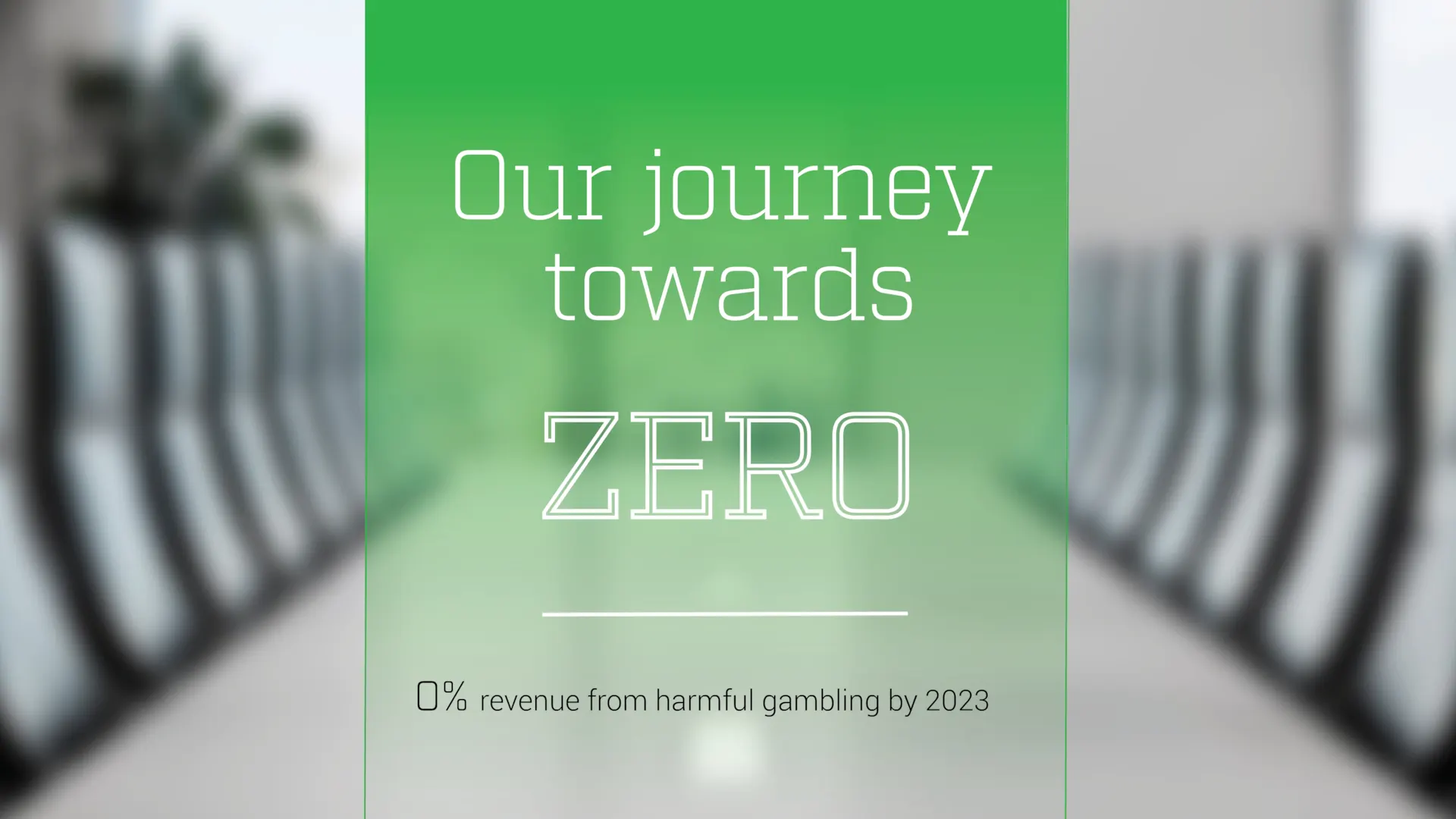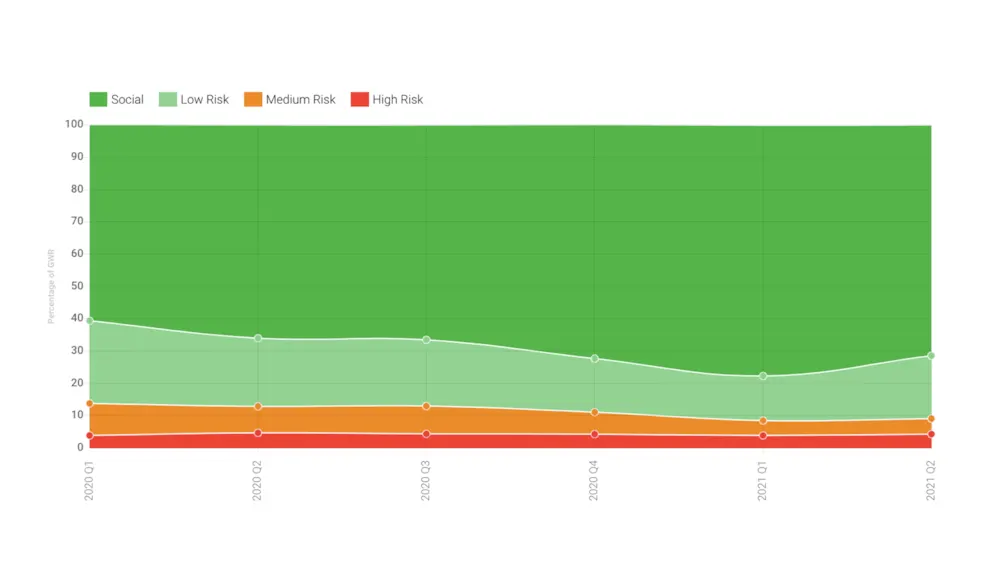
Kindred Group became the first gambling operator to report its share of revenue derived from high-risk players who show signs of harmful gambling. Our aim is to increase transparency and facilitate a fact-based debate. Openly reporting our data is aligned with Kindred’s purpose “To transform gambling by being a trusted source of entertainment that contributes positively to society." It is also a part of our commitment to reach zero per cent of revenue from harmful gambling by 2023.
 We have openly communicated the numbers in two consecutive quarters and the figures will be updated and published on our website each quarter, together with a measurement of the effectiveness of the Group’s sustainability work. We want to measure our progress and benchmark against our ambitions, as well as pave the way for the wider industry to follow in our footsteps.
We have openly communicated the numbers in two consecutive quarters and the figures will be updated and published on our website each quarter, together with a measurement of the effectiveness of the Group’s sustainability work. We want to measure our progress and benchmark against our ambitions, as well as pave the way for the wider industry to follow in our footsteps.
We asked Maris Catania, Head of Responsible Gaming & Research to analyse the numbers for Q2 and answer some of our questions.
Maris, Kindred Group made the decision earlier this year to reveal the percentage of revenue derived from harmful gambling. What is the purpose behind this?
Kindred has committed to zero per cent revenue from harmful gambling by 2023. The only way we can really commit to something like this and manage to monitor it, is by reporting the percentage of revenue derived from harmful gambling. We decided to take a broad approach, by reporting the amount of revenue coming from customers who disclose addiction, those who self-excluded (as it’s used as a proxy measure in a lot of research papers) and the highest risk classification on our monitoring system Player Safety Early Detection System, PS-EDS, which was to cover this from most angles, and encourage other operators to follow.
To validate the scientific method behind the PS-EDS methodology, we are working on a research paper that will be thoroughly reviewed by external and unbiased experts in the research community. We are also reaching out to any interested researchers who would like to validate our system.
What have the reactions been so far?
Overall, the reactions have been very positive. We understand that these percentages still translate into a high amount of money, but reporting such numbers encourages a more transparent approach. There were some negative reactions around the transparency and motivation behind these numbers, but I think this is more a result of the lack of trust that is present in the gambling industry. Seeing that there is a proportion of people who suffer from gambling addiction, and the high number of affected others, there is a reason for this lack of trust.
Gambling is one of our most popular pastimes across the world, yet the stigma remains due to the addiction often being hidden and the impact it can have on affected others. Nonetheless, there are several myths and a lack of a fact-based discussion. We would like to contribute to a discussion that is not based on false statistics. As an operator and the industry in general, we need to work on getting trust by practising what we preach and put responsible gambling at the top of the agenda.
How does Kindred monitor the ambition of zero per cent revenue from harmful gambling?
We are continuously working on improving responsible gambling internally and working with treatment centres, researchers and experts by experience. Having this ambition across the whole group really gives responsible gambling a seat at the bigger tables to make changes and help customers in a proactive manner. We have also set out a roadmap for our journey towards zero.
In this roadmap, we list all the important steps that we already have taken such as, building a real-time monitoring capability by updating PS-EDS, adding a re-enforcement learning element to PS-EDS to continually improve the accuracy of detections, adding additional machine learning algorithms to the PS-EDS framework and inviting external researchers to evaluate PS-EDS. It also outlines all the important steps ahead. We aim to improve the real-time data capability across all markets and brands and investigate better interventions once a customer is detected. We will also engage with regulators and define common objectives in hopes of eradicating harmful gambling. As robust licence systems are set in place, we must ensure the regulators understand the need to widen the scope of national self-exclusion registers to include adjacent industries such as consumer loan providers.
On the technical side, we have invested heavily in developing technologies to detect and prevent problem gambling. We use our knowledge to create a digital fingerprint of our customers’ behaviour. This fingerprint allows us to monitor, detect and follow up on problem activities. We then provide targeted customer protection, which is a central part of building a safe and responsible gambling environment. Our player monitoring system (PS-EDS) detects early signs of problem gambling and is a major pillar in Kindred’s sustainable gambling approach.
This is Kindred’s third reporting of the numbers. What is the difference that we can see?
We saw initially that there was a slight decrease in Q1. This was because we launched an updated version of PS-EDS, which is more behaviorally based, rather than financially based. Financial indicators are more based on how much money is lost, whereas behavioural indicators are more about how customers act on the website. For example, a financial indicator would be an increase in the deposits, whereas a behavioural indicator would be a customer who is constantly looking at the responsible gambling page and not taking action. The transition happened as behaviours precede the financials and therefore, make earlier interventions than before possible. The reason for this was to try to detect markers of harm in some cases, even before the customer’s money is lost. What we are seeing now is that in Q2, the percentage has increased slightly.

Kindred puts its customers in different risk categories. What are the main reasons behind the increase in harmful revenue from high-risk customers during Q2?
I think this might be a mixture of things. Our monitoring system, PS-EDS, is being constantly updated and improved, and therefore we have seen an increase in the customers detected. Our Responsible Gambling teams are working on being more proactive and taking faster action from detection to intervention, which also means that in some cases, self-exclusion is being promoted even more.
Can you say anything about how it will progress long-term?
This only emphasises the testament that as a company we need to continue working on getting the percentage down. We will see individual quarters show an increase, such as this one, as we have communicated before. But the long-term trajectory is expected to see a decrease in numbers. I would like to emphasise that this is not just a tick-a-box exercise for us, and this commitment doesn’t only apply to the Responsible Gambling team. We can only make changes is if we work together with different departments.
Do we address this going forward?
Currently, PS-EDS is based on manual interventions in most cases. We are working across different departments together to detect more customers and develop automated interventions. The intention is to have a real-time intervention. By working with the different experts in the organisation, we are investigating the best methodology to detect customers on the lower risks of the PS-EDS spectrum, and through effective communication, we will prevent customers from reaching that higher risk category.
